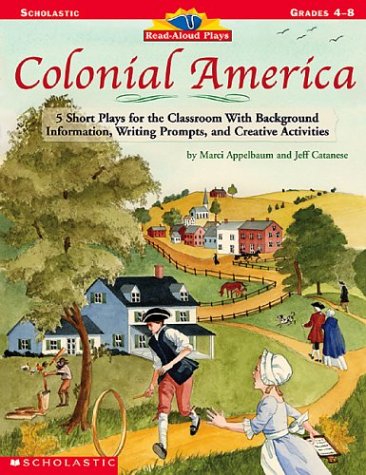-
Clothes in Colonial America
Mark Thomas
Paperback (Children's Press, March 1, 2002)Learn what it is like to dress in colonial times.Simple text and photographs depict the clothes worn by people in Colonial America. F
F
-
School in Colonial America
Shelley Swanson Sateren
Library Binding (Capstone Press, Aug. 1, 2016)Explores the school day of colonial children in the New England, Middle and Southern Colonies. Details the typical schoolteacher and urban and rural schoolhouses. Includes an activity to connect today’s reader with the past. U
U
-
Colonial America
Marci Appelbaum, Jeff Cantanese
Paperback (Teaching Resources, Oct. 1, 2003)Plays are the perfect way to show the story” in history. The five original plays in this collection cover key topics in colonial American history including Jamestown, the first Thanksgiving, triangular trade, the Salem witch trials, and daily life in the French, Spanish, and English colonies. Each play is paired with creative cross-curricular activities, literature and Web links, and background information. For use with Grades 4-8.
-
Science in Colonial America
Brendan January
Library Binding (Franklin Watts, March 1, 1999)Describes the scientific contributions made by people in colonial America, including natural history, medicine, astronomy, and electricity U
U
-
Religion in Colonial America
Jon Butler
Hardcover (Oxford University Press, May 18, 2000)Many people believe that the piety of the Pilgrims typified early American religion. However, by the 1730s Catholics, Jews, and Africans had joined Native Americans, Puritans, and numerous Protestant denominations in the colonies. Jon Butler launches his narrative with a description of the state of religious affairs in both the Old and New Worlds. He explores the failure of John Winthrop's goal to achieve Puritan perfection, the controversy over Anne Hutchinson's tenacious faith, the evangelizing stamina of ex-slave and Methodist preacher Absalom Jones, and the spiritual resilience of the Catawba Indians. The meeting of these diverse groups and their varied use of music, dance, and ritual produced an unprecedented evolution of religious practice, including the birth of revivals. And through their daily interactions, these Americans created a living foundation for the First Amendment. After Independence their active diversity of faiths led Americans to the groundbreaking idea that government should abandon the use of law to support any religious group and should instead guarantee free exercise of religion for everyone. Religion in American Life explores the evolution, character, and dynamics of organized religion in America from 1500 to the present day. Written by distinguished religious historians, these books weave together the varying stories that compose the religious fabric of the United States, from Puritanism to alternative religious practices. Primary source material coupled with handsome illustrations and lucid text make these books essential in any exploration of Americas diverse nature. Each book includes a chronology, suggestions for further reading, and index. X
X
-
Medicine in Colonial America
Charlie Samuel
Library Binding (Powerkids Pr, Sept. 1, 2003)Discusses various ways settlers and Native Americans practiced medicine during colonial times, describing diseases, supplies, and common practices. S
S
-
The City in Colonial America
L H Colligan, Louise Colligan
Library Binding (Cavendish Square, Aug. 1, 2014)Examines the role of cities and the lives of those within them during the colonial era of American history. V
V
-
Life in colonial America
Elizabeth George Speare
Hardcover (Random House, March 15, 1963)1963 Random House - Landmark Giants Series Hardcover T
T
-
A Kid's Life in Colonial America
Sara Machajewski, Sarah Machajewski
Paperback (Powerkids Pr, Jan. 1, 2015)In the early 17th century, all the world knew of North America came from reports of the earliest European explorers. By the end of the 18th century, the world knew America as the United Statesa country whose earliest years were shaped by colonialism. This historical, non-fiction text examines life in Colonial America through the eyes of the kids who lived there. Age-appropriate language takes readers inside the clothes, toys, schools, and ways of life in the 17th and 18th centuries. Fact boxes provide opportunities for additional learning. A glossary and index round out the text, completing a comprehensive learning experience. S
S
-
Colonial America
Patrice Sherman
Library Binding (Mitchell Lane Publishers, Aug. 3, 2009)If you grew up in colonial America, making your bed would mean more than just tucking in the sheets and pulling up the spread. You d have to gather hay to stuff a straw-tick mattress and pluck a goose for a cozy down quilt. Colonial kids whittled pegs, spun thread, churned butter, and even cooked up their own soap in big iron kettles. Between chores, they learned the alphabet from hornbooks they wore around their necks. Yet no matter how hard they worked, they still had time for a game of blindman s bluff or king of the hill. How did they do all this? Maybe they took a tip from the mysterious Poor Richard, who said, Have you something to do tomorrow? Do it today. Meet Hopewell of Bayberry Cove and many other children of the American colonies. (And find out who Poor Richard really was!) T
T
-
Colonial America
D. Thorp
Hardcover (Grolier Academic Reference, Feb. 16, 1998)Book by
-
Colonial America
Deirdre Clancy Steer, Amela Baksic
Hardcover (Chelsea House Publications, May 1, 2009)In this work, readers will learn how men and women dressed, from the earliest settlers to those who fought in the Revolutionary War, from the rich landowners to the poorest servants.